Multilevel Analysis on the Contextual Effect of the Integrated Health Post Activity on Development of Children Under Five in Kubu Raya, West Kalimantan
Abstract
Background: It is estimated that 200 million children in developing countries do not develop optimally. Child development is a complex improvement in body structure and function that include gross and fine motoric, speech, language, socialization, and independence aspects of development. The success of children in achieving optimal development determines the future of a nation. The purpose of this study was to analyze the contextual effect of integrated health post (posyandu) in child development in Kubu Raya District, West Kalimantan.
Subjects and Method: This study was a cross sectional conducted at 25 integrated health post in Kubu Raya District, West Kalimantan, from November to December 2018. A sample 200 of children under five was selected by simple random sampling. The dependent variable was child development. The independent variables were maternal age at marriage, maternal education, parental income, parenting style, birth weight, birth length, child development monitoring, child development intervention, and integrated health post strata. Data collection was conducted using questionnaire and analyzed using multilevel logistic regression analysis in Stata 13.
Results: Child development disorder increased with early maternal age at marriage (b= 3.18; 95% CI= 0.77 to 5.59; p = 0.010), but decreased with high maternal education (b= -2.22; 95% CI= -3.92 to -0.52; p= 0.010), high parental income (b= -4.01; 95% CI = -6.55 to -1.47; p= 0.002), proper parenting style (b= -2.89; 95% CI= -5.18 to -0.60; p= 0.013), normal birth weight (b= -2.87; 95% CI= -4.80 to -0.95; p= 0.003), normal birth length (b= -3.13; 95% CI= -5.63 to -0.63; p= 0.014), child development monitoring (b= -2.97 95% CI= -5.58 to -0.36; p= 0.025), and child development intervention (b = -3.53; 95% CI= -6.19 to -0.87; p= 0.009). The integrated health post had a contextual effect on child development with ICC= 19.9%.
Conclusions: Child development disorder increases with early maternal age at marriage, but decreased with high maternal education, high parental income, proper parenting style, normal birth weight, normal birth length, child development monitoring, and child development intervention. The integrated health post has a contextual effect on child development.
Keywords: child development, children under five, multilevel analysis
Correspondence: Lolita. Public Health Masters Program, Universitas Sebelas Maret, Jl. Ir Sutami 36A, Surakarta, Central Java, Indonesia. Email : Patricialolita25@gmail.com Seluler: 082328463344.
Journal of Maternal and Child Health, 2019, 4(4): 222-229
https://doi.org/10.26911/thejmch.2019.04.04.01
References
Badan Pusat Statistik (BPS) (2012). Survei Demografi dan Kesehatan Indonesia (SDKI) 2012. Jakarta. Website
Badan Pusat Statistik (BPS), UNICEF 2016. Analisis Data Perkawinan Usia Anak di Indonesia. Jakarta. Website
Datar, A. Jacknowitz, A (2009). Birth weight effects on children
Efevbera, Y,. et al (2017). Girl child marriage as a risk factor for early childhood development and stunting. Social Science and Medicine Journal. 185: 91-101. doi: 10.1016/j.socscimed.2017.05.027 Crossref PubMed Google Scholar
Escamilla, P R., Moran, V. H (2016). The role of nutrition in integrated early child development in the 21st century: contribution from the Maternal and Child Nutrition journal. Maternal & Child Nutrition, 13(1): e12387. doi: 10.1111/mcn.12387 Crossref PubMed Google Scholar
Ford, N D., Stein, A D (2015). Risk factors affecting child cognitive development: a summary of nutrition, environment, and maternal
http://www.depkes.go.id/resources/download/lain/Buku%20Program%20Indonesia%20Sehat%20dengan%20Pendekatan%20Keluarga.pdf">Website
Ministry of Health (2016). Pedoman Pelaksanaan Stimulasi, Deteksi dini dan Intervensi Dini Tumbuh Kembang Anak. Jakarta. Website
Kemenkes RI (2011). Pedoman Umum Pengelolaan Posyandu. Jakarta. Website
Kemenkes RI (2011). Riset Hasil Kesehatan Daerah. Direktorat Jendral Kesehatan Ibu dan Anak. Jakarta
Khalifatunisak, A., Salimo, H., Dewi, Y L R (2018). Multilevel Analysis on the Determinants of Overweight among Children Under Five in Kediri, East Java. Journal of Maternal and Child Health. 3(4): 261-268. doi: 10.26911/thejmch.2018.03.04.03 Crossref Google Scholar
Maggi, S., Irwin Lori J, Siddiqi A, Hertzman C (2010). The social determinants of early child development: An overview. Jurnal of Pediatric and Child Health. 46 (11): 627-635. doi: 10.1111/j.1440-1754.2010.01817.x Crossref PubMed Google Scholar
Murti B. 2018. Prinsip dan Metode Riset Epidemiologi Edisi keempat. Sura-karta: Program Studi Ilmu Kesehatan Masyarakat, Program Pascasarjana, Universitas Sebelas Maret.
Ribeiro, CC. Regina, MOP. et al (2017). Development skills of children born premature with low and very low birth weight. 29(1). doi: 10.1590/2317-1782/20162016058 Crossref PubMed Google Scholar
Richter, L M, Lombardi J, et al (2016). Investing in the foundation of sustainable development: pathways to scale up for early childhood development. 389(10064): 103-118. doi: 10.1016/S0140-6736(16)31698-1 Crossref PubMed Google Scholar
Stolt, S., Korja, R., Matom
Aoxing Ye, Shuangqin Yan, Kun Huang, Leijing Mao, Xing Ge, Tingting Weng, Azhu Zuo, Xingyong Tao, and Fangbiao Tao (2018). Maternal intelligence quotient and motor development in early childhood: The mediating role of mother
Zachrisson, HD, Dearing. E 2015. Family Income Dynamics, Early Childhood Education and Care, and Early Child Behavior Problems in Norway. 86(2): 425-440. doi: 10.1111/cdev.12306 Crossref PubMed Google Scholar
Jane J. Lee, Kush Kapur, Ema G. Rodrigues, Md Omar Sharif Ibne Hasan, Quazi Quamruzzaman, Robert O. Wright, David C. Bellinger, David C. Christiani, et al (2017). Anthropometric measures at birth and early childhood are associated with neurodevelopmental out comes among Bangladeshi children aged 2











